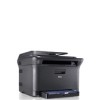Dell 1235cn Color Laser Printer User's Guide - Page 19
Add TCP/IP Port, X:\Setup.exe
 |
View all Dell 1235cn Color Laser Printer manuals
Add to My Manuals
Save this manual to your list of manuals |
Page 19 highlights
1. Connect the network cable to your printer. 2. Ensure that the network setup for your printer is completed. See "Setting up the network" on page 18. All applications should be closed on your computer before beginning installation. 3. Insert the Printer Software CD into your CD drive. The CD should automatically run, and an installation window appears. If the installation window does not appear, click Start → Run. Type X:\Setup.exe, replacing "X" with the letter which represents your CD drive and click OK. If you are running Windows Vista, click Start → All Programs → Accessories → Run, and type X:\Setup.exe. If the AutoPlay window appears, click Run Setup.exe in Install or run program field, and click Continue in the User Account Control window. 4. Click Next. • The window shown above may differ slightly, if you are reinstalling the driver. 5. Select Typical installation for a network printer, and then click Next. 6. The list of printers available on the network appears. Select the printer you want to install from the list and then click Next. • If you do not see your printer on the list, click Update to refresh the list, or select Add TCP/IP Port to add your printer to the network. To add the printer to the network, enter the port name and the IP address for the printer. • To find a shared network printer (UNC Path), select Shared Printer [UNC] and enter the shared name manually or find a shared printer by clicking the Browse button. If you are not sure of the IP address, contact your network administrator or print network information. See "Printing reports" on page 49. 7. After the installation is complete, a window appears asking you to print a test page. If you wish to do so, select the corresponding checkbox(es) and click Finish. • If your printer does not work properly after the installation, try to reinstall the printer driver. See Software section for more information. • During the printer driver installation process, the driver installer detects the location information for your operating system and sets the default paper size for your printer. If you use a different Windows location, you must change the paper size to match the paper you usually use. Go to printer properties to change the paper size after installation is complete. Getting started | 19















